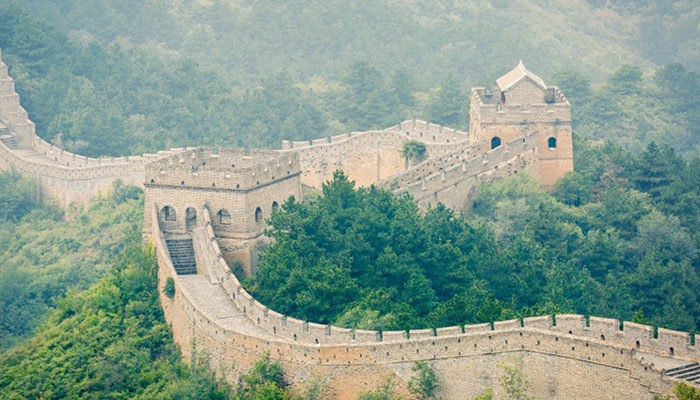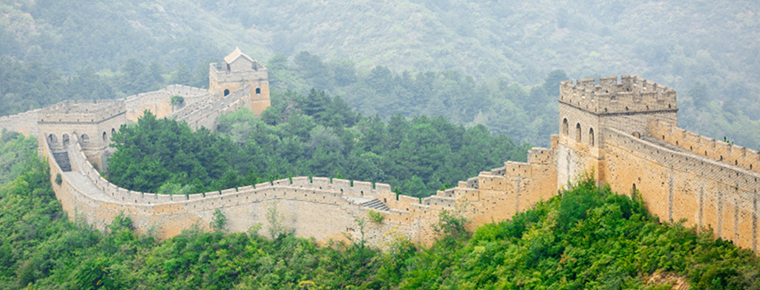The Great Wall
The Great Wall, also known as the Great Wall, is an ancient Chinese military defense project, is a tall, strong and continuous placanticline to limit the movement of the enemy riders. The Great Wall is not a single isolated wall, but a defense system with the city wall as the main body, combined with a large number of cities, barriers, pavilions and signs.

The history of the construction of the Great Wall can be traced back to the Western Zhou Dynasty, where the famous allusion "the princes of beacon fire opera" occurred in the capital of Haojing (now Xi'an, Shaanxi Province). During the Spring and Autumn Period and the Warring States Period, the nations fought for hegemony and defended each other. The construction of the Great Wall reached its first climax, but the length of the building was relatively short. After the unification of the six kingdoms, the first emperor of Qin connected and repaired the the Great Wall of the Warring States period. The Ming Dynasty was the last dynasty to overhaul the Great Wall. The the Great Wall that people see today is mostly built at this time.

Great Wall resources are mainly distributed in Hebei, Beijing, Tianjin, Shanxi, Shaanxi, Gansu, Inner Mongolia, Heilongjiang, Jilin, Liaoning, Shandong, Henan, Qinghai, Ningxia, Xinjiang and other 15 provinces and cities. Shaanxi is the most abundant province in China's the Great Wall. The the Great Wall is 1838 kilometers long. According to the national survey of the Great Wall resources conducted by the Department of cultural relics and surveying and mapping, the total length of the Great Wall of the Ming Dynasty was 8 851.8 km, the Qin and Han Dynasties and the early Great Wall exceeded 10,000 km and the total length exceeded 21,000 km.

In March 4, 1961, the Great Wall was declared the first batch of national key cultural relics protection units by the State Council. In December 1987, the Great Wall was listed as a world cultural heritage.


-
1.The Beijing Palace Museum
The Beijing Palace Museum was established on October 10, 1925, and is located in the Forbidden City of the Beijing Palace Museum. Based on the palaces of Ming and Qing dynasties
Time 2018-11-24 -
2.China of chunqiu yancheng tourist area
China Spring and Autumn Yancheng Tourist Area (also known as Yancheng, Spring and Autumn Yancheng) is located in the central city of Wujin District, Changzhou City
Time 2018-12-06 -
3.Zhenbeibao West Film City
Zhenbeibao Western Film City, located in Yinchuan City, Ningxia Hui Autonomous Region, is a national AAAAA-level tourist attraction integrating sightseeing, entertainment, leisure, catering and shoppi
Time 2018-12-12 -
4.Chengdu Shangri La Hotel
Chengdu Shangri-La Hotel belongs to Shangri-La Hotel Group. It was officially completed and put into use on May 20, 2007. The hotel is located at No. 9 Binjiang East Road, Chengdu City
Time 2018-12-16 -
5.Feng Guo Temple
Fengguo Temple is located in Yixian County, Jinzhou City, Liaoning Province, China. It was founded in the ninth year of Kaitai, Liaoning Province (1020). It was first named Xianxi Temple and later cha
Time 2019-01-12 -
6.Beijing storytelling
Beijing Book Review is a traditional art of rap and singing. Legend has it that Liu Jingting (1587-1668), a Southern Jiangnan storyteller, came to Beijing in the late Ming and early Qing Dynasties
Time 2019-04-04 -
7.Tibetan Engraving and Printing Skills of Dege School of Printing
Tibetan engraving and printing skills of Dege Printing Institute, local traditional handicraft skills of Dege County, Sichuan Province, and one of the national intangible cultural heritages.
Time 2019-04-26 -
8.High cavity
Gaoqiang is one of the four major tunes in Chinese opera. Gaoqiang was originally called "Yiyang Cavity" or "Yiqiang Cavity", because it originated in Yiyang, Jiangxi Province.
Time 2019-04-30 -
9.Jiangzi dama Festival
Dama Festival: It is a traditional Tibetan program with unique style in Jiangzi area of Tibet. It is said that the first Dama Festival is a horse race and archery competition held to celebrate the com
Time 2019-05-05 -
10.Kirgiz embroidery
Kirgiz embroidery is a traditional embroidery in Wensu County, Xinjiang Uygur Autonomous Region, China. Kirgiz women are good at embroidery. They embroider various delicate patterns on headscarves, pi
Time 2019-05-09 -
11.Neijiang social security
In 2019, there were 109600 people participating in the endowment insurance (including retirees) of government institutions, 842500 people of enterprise employees (including retirees), and 1501700 people of urban and rural residents. 52100 new urban jobs
Time 2020-12-16 -
12.Dazhou Tourism
Dazhou, located in the east of Sichuan Province, has jurisdiction over 4 counties, 2 districts and 1 city, covering an area of 16600 square kilometers and a total population of 7 million. It is a city with a large population, rich resources, an important indu
Time 2020-12-20